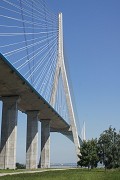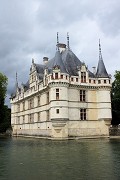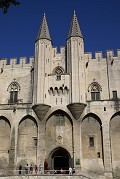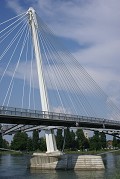A Tour de France in Structures
Francophiles may already have done this kind of Tour de France in Structures and may not find many new sites. For those never having been to France and wanting to explore it, this may be a succinct overview of more than two thousand years of construction history and culture by which one could explore France in an upcoming trip, or more likely in several trips. With more than 12.000 structures listed for France in Structurae – more than for any other country –, it's also a selection of some of the most important structures in the database. Of course one could select a completely different set of structures and still not cover everything one should see in France, so any Tour de France in Structures is always going to be a suggestion or a subjective recommendation. The built heritage in France is extremely varied ranging from Roman aqueducts to medieval cathedrals and bridges to the most modern engineering structures and architecture that can be imagined so making a selection is far from simple.
1. Eiffel Tower and & Notre Dame in Paris
Any civil engineer should go see the Eiffel tower, that landmark in Paris which you can see from almost anywhere in the city and is just impossible to avoid. In good weather the view from the top is no less than amazing. The lines for going up by elevator can be extremely long, though, especially when not all of them are working. After the Eiffel tower one can take the Métro, a boat or just walk over to the Île de la Cité to see Notre Dame de Paris. As one of the earliest Gothic cathedrals it is not as airy or lightly built as later ones but its freshly cleaned façade and location along the Seine provide for an unequalled ambiance. Of course one could just skip the Tour of France entirely and just explore Paris for the entire vacation, but that may end up being somewhat costly.
2. Cathedrals of Beauvais and Amiens
The builders of the Cathedral at Beauvais wanted to go higher than ever before and did. The ribbed stone vaults are the highest ever built. But after two collapses the endeavor came to a halt and was never completed. Only the choir remains, but those vaults are impressive as no others are by sheer size. Not far away at Amiens stands the largest medieval cathedral of France and is also quite impressive.
3. Le Havre: Normandy Bridge
The Seine estuary is a busy shipping lane and the river is deep enough to allow sea-going vessels to reach as far inland as Rouen. So crossing the Seine here requires a high clearance as well as a long span. Michel Virlogeux made the crossing into the largest-spanning cable-stayed bridge at the time – Normandy Bridge. As the surroundings are rather flat, the 200 meter high pylons can be seen from quite a distance.
4. Mont-Saint-Michel
The Abbey of Mont-Saint-Michel is not the largest building of the Middle Ages but due to it sitting on top of a rocky island in the middle of a bay, it has always been a challenging place for building anything. The entire bay has been declared a UNESCO world heritage site and is one of the most visited and touristy sites in France but also very romantic.
5. Bridges in Brittany
Brittany is not usually associated with bridges even though the region is full of interesting ones. Three of them are a definite highlight: Just outside of Brest which lies at the extreme tip of the peninsula Eugène Freyssinet built Albert Louppe Bridge in the town of Plougastel-Daoulas. Another bridge was built just next to it 60 years later. Iroise Bridge's cable stays provide a stark contrast to Freyssinet's massive arches. A few kilometers away at Térénez stands another cable-stayed bridge, designed also by Michel Virlogeux, in an extremely tight curve and featuring lambda-shaped pylons.
6. Castles along the Loire
Another romantic region of France lies along the Loire and its tributaries. There's probably no other area of Europe with as high a density in castles from the Middle Ages to the Renaissance. Among the most striking are Chenonceaux, Chambord, Azay-le-Rideau and Saumur. This region alone would be worth an entire vacation.
7. Eiffel's Viaduct at Garabit
Gustave Eiffel is known in France for more than just his tower. His earlier Viaduct at Garabit already gained him so much fame that he is just as known for that as for anything else he built later.
8. The A75 motorway and Millau Viaduct
The A75 motorway provides an alternative north-south route through the center of France and most of it is toll-free - the exception being the gigantic Viaduct at Millau that crosses the beautiful Tarn valley. The tip of the tallest pylon surpasses the Eiffel tower by quite a bit. Even though many sources claim that Norman Foster designed the Millau Viaduct, every engineer should know that in reality Michel Virlogeux did.
9. Roman Edifices in Nîmes and Arles
As any avid Asterix reader will know, all of Gaul was occupied by the Romans except for one little rebellious village. Near Nîmes one can find one of the largest aqueduct bridges from the Roman era, the Pont du Gard. It provided the Roman colony with fresh water. Nimes also has other Roman buildings that are still in use today, an amphitheater as well as a near perfectly preserved temple, the Carré d'Art. Nearby Arles also features a Roman-era amphitheater as well as an antique theater and, most interestingly, an underground cryptoporticus beneath the town hall.
10. Papal Residence at Avignon
Instead of in Rome, a number of popes actually lived in Avignon for a while during the Middle Ages, followed by a number of antipopes afterwards. Regardless of whether they were legitimate or not, they built themselves a nice monument, the Pope's Palace, to which nothing compares even in Rome. The city's ramparts where built in the same style. Of course the bridge mentioned in the famous song about dancing on the bridge in Avignon is real and called Saint-Bénezt bridge.
11. Modern Architecture in Marseille
Marseille may have been founded by Phoenecians in pre-Roman times but Marseille has also become quite a hotbed of modern architecture recently. Next to Le Corbusier's Cité radieuse some structures were completed very recently such as a Zaha Hadid-designed skyscraper and the new Museum of the Civilizations of Europe and the Mediterranean. The latter makes use of the advantages of ultra-high perfomance concrete like no other structure before.
12. Along the Rhone by TGV
High-speed trains have been running between Marseille and Paris since 1981 but it's only in 2001 that nearly the entire 750 kilometers of track become truly high speed for the entire length. Travelling time is now down to three hours. The last section, the LGV Méditerranée, features a number of signature bridges such as the twin viaducts near Avignon, Garde Adhémar Viaduct or those at Vernègues and Ventabren.
13. Lyon Under Construction
Sitting at the confluence of the rivers Rhone and Soane, France's thrid largest city of Lyon has always needed many bridges. The first new Rhone crossing in 30 years is to be opened soon but right next to it the Musée des Confluences, designed by Copp Himmelb(l)au, will remain under construction until the end of 2014 probably but is already quite a sight to see.
14. Old and New in Straßburg and Metz
The medieval cathedrals of both Strasbourg and Metz certainly dominate their respective cities but modern architecture has become more prominent in both cities recently. Since 2010 Metz has a dependency of the Centre Pompidou which was designed by Shigeru Ban und built mostly in wood. In Strasbourg the Passerelle des Deux Rives by Marc Mimram crosses the Rhine towards Kehl in Germany and the multimodal hub at Strasbourg station is an unusual modern shell of steel and glass.
15. Stone and Concrete in Reims
Just as in Paris, there also is a Cathédrale Notre-Dame in the center of Reims. But royally speaking, the cathedral at Reims was more important for a long time because the majority of the French kings were crowned there. German artillery fire intentionally destroyed the wooden roof above the vaults during WWI. It was replaced with a unique structure made of precast concrete elements. Another important concrete structure in Reims are the Halles Boulingrin which used to house the central market. Eugène Freyssinet was responisble for the erection of the concrete shells.













